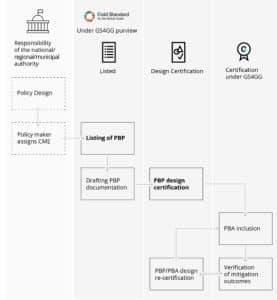In the fight against climate change, effective emission reduction policies are more essential than ever. Gold Standard, the leading Geneva-based nonprofit, drives ambitious climate action through solid standards and verified impacts and is rolling out new norms for government emission reduction policies. This innovative initiative, currently in its pilot phase, will provide governments with a robust framework to certify and validate the impact of their emission reduction efforts.
Unveiling Gold Standard’s Groundbreaking Climate Certification Initiative
The press release states that:
Gold Standard’s Policy Requirements and Procedures allow for the certification and crediting of greenhouse gas reductions or removals achieved as a result of the introduction of new policies or regulations.
This policy represents a significant advancement in the field of carbon finance, creating a pathway for governments to receive recognition and financial support for their climate policies.
Building Trust in Emission Reduction Policies
Adhering to Gold Standard’s rigorous criteria ensures the credibility and effectiveness of emission reduction policies. Governments can demonstrate the real-world impact of their initiatives, enhancing transparency and building trust among stakeholders, including international organizations, investors, and the general public.
How the Certification Process Works
The certification process under Gold Standard’s new initiative involves several key steps:
1. Policy Assessment
Governments submit their emission reduction policies for evaluation. This includes a detailed analysis of the policy’s design, implementation strategy, and expected outcomes.
2. Impact Evaluation
It conducts a thorough review to assess the actual impact of the policy. This involves measuring the reduction in greenhouse gas emissions and other environmental benefits.
3. Verification and Certification
Once the impact is verified, the company issues a certification along with carbon credits that can be used to attract funding and investment.
 source: Gold Standard
source: Gold Standard
How Governments Benefit from Gold Standard’s Climate Policy
Governments that participate in this certification process stand to gain numerous benefits:
- Increased Credibility: Certification by a reputed body like Gold Standard enhances the credibility of their climate policies.
- Financial Incentives: Certified emission reductions can be translated into carbon credits, opening new avenues for carbon finance.
- International Recognition: Certification provides international recognition, positioning governments as leaders in climate action.
The Broader Impact on Climate Action
Gold Standard’s new certification norms can potentially drive significant progress in global climate action. This initiative encourages governments to implement more ambitious and effective climate policies by providing a reliable framework for evaluating and certifying emission reductions. Furthermore, the financial incentives associated with certification can help mobilize additional resources for climate action.
By pioneering these new norms, the company is helping governments prove the effectiveness of their emission reduction policies and secure the financial support necessary to scale up their efforts. This initiative marks a significant step forward in the global fight against climate change. We can infer, that it sets a new standard for transparency, accountability, and impact in climate policy.
- FURTHER READING: Gold Standard Suspends Russian Carbon Project (carboncredits.com)

